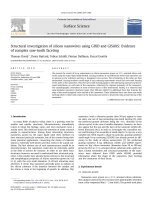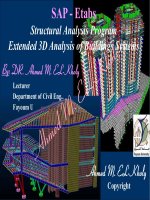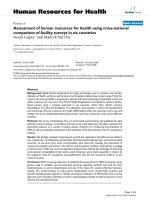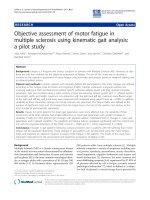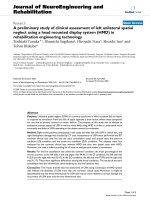Structural damage assessment of building structures using dynamic experimental data (p 1 8)
Bạn đang xem bản rút gọn của tài liệu. Xem và tải ngay bản đầy đủ của tài liệu tại đây (163.3 KB, 8 trang )
THE STRUCTURAL DESIGN OF TALL AND SPECIAL BUILDINGS
Struct. Design Tall Spec. Build. 13, 1–8 (2004)
Published online in Wiley Interscience (www.interscience.wiley.com). DOI:10.1002/tal.227
STRUCTURAL DAMAGE ASSESSMENT OF BUILDING
STRUCTURES USING DYNAMIC EXPERIMENTAL DATA
HEUNG-SIK KIM1 AND YOUNG-SOO CHUN2*
1
2
Department of Architecture, Honam University, Kwang-ju, Korea
Department of Structural Eng., Korea National Housing Corporation, Kyeonggi-do, Korea
SUMMARY
Detection of damage to structures has recently received considerable attention from the viewpoint of maintenance
and safety assessment. In this respect, the vibration characteristics of buildings have been applied consistently to
obtain a damage index of the whole building, but it has not been established as a practical method until now. It
is reasoned that this is perhaps due to restrictions on the experiment, use of improper method, and lack of inspection opportunity for the structures. In addition, in the case of large-scale structures such as buildings, many variables to be considered for the analysis contribute to a large number of degrees of freedom, and this can also be
a considerable problem for the analysis. A practical method for the detection of structural damage using the first
natural frequency and mode shape of building is proposed in this paper. The effectiveness of the proposed method
is verified by numerical analysis and experimental tests. From the results, it is observed that the severity and location of the damage can be estimated with a relatively small error by using modal properties of building. Copyright © 2004 John Wiley & Sons, Ltd.
1.
INTRODUCTION
The trend of constructing bigger and higher buildings demands greater safety caution for these structures. A diagnosis of structural integrity of these buildings involves an assessment of whether they can
serve safely, and its current assessment techniques rely on a visual inspection or localized destructive
and non-destructive tests. In this case, the quality of the assessment is influenced by the experience
and knowledge of each investigator. Furthermore, the investigators are faced with problems in assessing an unapproachable element and in an area where direct visual inspection is difficult. In addition,
the result of a localized inspection does not represent the condition in whole structures, and it is necessary to inspect a considerable area to represent the condition of the building at large. After all, these
constraints imply that current assessment techniques are time-consuming, labour-intensive, and costly.
These problematic issues have stimulated a search for a better method, and recently many research
attempts to accomplish this purpose have been continuing using dynamic characteristics of vibration
tests of the building (Goh et al., 1995; Li et al., 1999; Hassiotis and Jeong, 1993).
Structural damage to buildings can occur due to cracking, ageing of materials etc. and is indicated
by a change in physical and modal parameters of structural system. These parameters can be used as
an index of such damage detection. This concept has recently been applied in many research studies
for damage detection of various structures (Stephens and Yao, 1987; Goh et al., 1995; Liu, 1995;
Bicanic and Chen, 1997; Li et al., 1999; Hassiotis, 2000). In this case, most of these methods require
limited information on measured modal parameters such as natural frequency or mode shape for the
* Correspondence to: Young-Soo Chun, Department of Structural Engineering Korea National Housing Corporation, 175
Kumi-dong, Pundang-gu, Sungnam-shi, Kyonggi-do, 463-500 Korea.
Copyright © 2004 John Wiley & Sons, Ltd.
Received October 2002
Accepted November 2002
2
H.-S. KIM AND Y.-S. CHUN
identification of structural damage or quantification of such damage. However, up to now, no method
has been able to provide this function reliably for large structures, and it is more so for the case of
building structures. It is reasoned that this is perhaps due to restrictions on the experiment, incorrect
method, and lack of inspection opportunity for the structures. In addition, for the case of large-scale
structures such as buildings, many variables to be considered for the analysis contribute to a large
number of degrees of freedom (DOFs), and this can also be a considerable problem for the analysis.
Thus, this study, as an attempt at such analysis, takes a practical approach to use only first modal
vibration characteristics of buildings to overcome the difficulties of the field experiment, proposes a
method for damage detection by simple modelling of the buildings for each storey, and verifies its
usefulness.
2.
DAMAGE DETECTION ALGORITHM
The damage detection algorithm used in this research is a method to detect local damage using the
change of stiffness of each storey of a multi-storied building based on the modal information as measured and obtained in the field. It requires first natural frequency and mode shape only as the input
data. Here, local damage refers to not each element level but each storey level, and structural damage
is indicated by the decrease in stiffness of each storey due to damage to each element. Thus, it is
assumed that any change in storey stiffness is solely due to change in the sum of column or wall stiffnesses at that storey, and the stiffness of each storey of the damaged building can be represented by
the product of a damage index and stiffness of each storey of the undamaged building as shown in
Equation (1).
NL
Ki* = Â a i Ki
(1)
i =1
Here, ai represents the damage index of ith storey, Ki, K*i is the contribution of the ith storey on the
global stiffness matrix of the undamaged and damaged structure respectively, and NL is the number
of elements of the structures with n degrees of freedom. ai can provide information not only on the
location of the damage but also the severity of the damage. The damage index, ai, is obtained using
the following algorithm. First, the eigenvalue problem of an undamped free vibration equation of
undamaged structure with n-DOF can be written as follows (Clough and Penzien, 1993):
( K - l j M )f j = 0
(2)
Here, lj is the eigenvalue (= wj2) of the jth vibration mode, and fj is the corresponding natural mode
shape of the system. Equation (2) can then be rewritten as
[K ]{f j } = w 2j [ M ]{f j }
(3)
It is assumed that damage is not accompanied by a change in mass. However, a change in stiffness
produces changes in the eigenvalues and eigenvectors. Therefore, the eigenvalue problem of the
damaged structure is given by
[K *]{f *j } = w *j 2 [ M ]{f *j }
(4)
The left-head side of Equation (4) can be rewritten by substituting Equation (1) as in Equation (5):
[K *]{f *j } = [ D*][K ]{a i }
Copyright © 2004 John Wiley & Sons, Ltd.
(5)
Struct. Design Tall Spec. Build. 13, 1–8 (2004)
DAMAGE ASSESSMENT USING DYNAMIC EXPERIMENTAL DATA
3
where
Èf1*jf 2*j ◊ ◊ ◊ ◊ ◊ ◊ f *N
0 ◊◊◊◊◊◊ 0
Í
*
Í f1*j ◊ ◊ ◊ ◊ ◊ ◊ 0 f2*jf3*j ◊ ◊ ◊ f Nj
Í
[ D*] = Í
f1*j ◊ ◊ ◊ 0
f2*j ◊ ◊ ◊ 0
Í
O M
O M
Í
*
ÍÎ
f1 j
f2*j
È K1
ÍK
Í 1
ÍM
Í
Í0
Í0
[K] = Í
Í0
ÍM
Í
Í0
Í0
Í
ÍÎ 0
K2
- K2
M
0
K2
0
M
0
0
0
0
0
M
0
- K3
- K3
M
0
0
0
◊◊◊ 0 ˘
˙
◊◊◊ 0 ˙
˙
◊◊◊ 0 ˙
OM ˙
˙
* ˚˙
f Nj
(6)
◊◊◊◊◊◊
◊◊◊◊◊◊
O
0 ˘
0 ˙
˙
M ˙
˙
0 ˙
◊◊◊◊◊◊
0 ˙
˙
◊◊◊◊◊◊
0 ˙
O
M ˙
˙
K N -2 K N -1 ˙
- K N -1 ˙
0
˙
K N ˙˚
0
{a i } = {a 1 , a 2 , a 3 , ◊ ◊ ◊ ◊ ◊ ◊ , a N }
T
(7)
(8)
Finally, Equation (9) for the solution of the damage index, aj, is obtained by
a i = w *j [ A][ M ]{f *j }
(9)
where [A] = {[D*][K]}-1.
As shown in Equation (9), the proposed algorithm makes the damage detection of the structure
in each storey possible with data on only one minimum mode. If information on several modes
can be obtained by experiment, an expanded equation as shown in Equations (4) and (5) is
possible. An optimization problem can then be solved for improvement in the accuracy of damage
detection.
3.
DAMAGE DETECTION PROCESS AND NUMERICAL EXAMPLE
Based in the proposed algorithm and the definition of damage to structures, a detailed method and
process for the detection of building damage is introduced and the usefulness of such a method is verified using a numerical example.
The example building chosen for the illustration of the proposed method is a residential building
with shear-wall dominant systems, which is widely used in Southeast Asia and is a 20-storey straight
linear flat apartment as shown in Figure 1(a). The story height is 2600 mm for all storeys. For the sake
of simplification of the analysis, it is assumed that all walls in the building are uniform. This example
assumes that a perfect analysis model has been set for the building before damage occurs.
The procedure for damage detection is straightforward and easy to implement, as described in the
following.
Copyright © 2004 John Wiley & Sons, Ltd.
Struct. Design Tall Spec. Build. 13, 1–8 (2004)
4
H.-S. KIM AND Y.-S. CHUN
(a)
(b)
Figure 1. Example building and condensed model. (a) Typical floor plan of the example building.
(b) Condensed model (numbers indicate condensed DOFs)
Step 1. First, according to the assumption previously introduced in Section 2, the sample building is
converted into a simple n-DOF system corresponding to n storeys as shown in Figure 1(b).
In this numerical example, the stiffness of each storey can be obtained by applying a unit load at each
storey. But, in a real problem, static condensation is performed to eliminate all rotational DOFs
(Guyan, 1965) and then, to narrow the gap between the condensed model with n-DOF lumped massspring system and the actual structure, system identification is performed.
First, full-scale measurements are carried out for the building, and by applying the random decrement technique on a time window of acceleration responses at each floor of the building, output-only
modal analysis is conducted. Then, by using the damage detection approach in Section 2, the stiffness
terms of the simple model are identified and then used to update the stiffness matrix of the complete
model.
Copyright © 2004 John Wiley & Sons, Ltd.
Struct. Design Tall Spec. Build. 13, 1–8 (2004)
5
DAMAGE ASSESSMENT USING DYNAMIC EXPERIMENTAL DATA
Table 1. Damage scenarios
Classification
Case 1
Case 2
Case 3
Case 4
Damage element
Degree of damage
Vibration mode used
2-storey
10-storey
17-storey
5-storey, 15-storey
20% decrease in stiffness
20% decrease in stiffness
20% decrease in stiffness
20% decrease in stiffness
First mode
First mode
First mode
First mode
Step 2. Parameters such as natural frequency and mode shape are needed for the damage detection
and are obtained by experiment.
In this numerical example, the damage at a particular storey is introduced by decreasing the stiffness
of the finite element model, and the modal information of the building before and after damage is
obtained by an eigenvalue analysis. In this case, the change in modal information is assumed to be
data measured from the field test, and the damage at a particular storey follows an assumed damage
scenario.
In this example, four damage scenarios were constructed to indicate a change in modal characteristics with respect to the severity of damage and the location of damage and to verify the usefulness
of the proposed detection method. Generally, most previous research has used a case of severe damage
in order to make the usefulness of the proposed method more visible and also applied a very unrealistically high mode for the natural frequency and mode shape. Nevertheless, the internal damage of
an aged building can be much less in reality, and the detection of such damage is considered to be
more useful in a practical sense. In addition, the number of vibration modes that can be obtained by
an actual measurement is very limited in the case of a building, and the validity of such measurements
is also very restricted. For those reasons, this example uses only the first mode and a lightly damaged
structure. Table 1 summarizes the damage scenario.
Step 3. As previously mentioned in Section 2, the decrease in stiffness is computed reversely. In this
case, the accuracy of damage detection can vary according to the number of vibration modes used,
the location and the severity of damage, etc. Therefore, the usefulness of the proposed method can be
examined with respect to the reversely computed amount of decrease in the stiffness.
In order to find out the detection result with respect to the location of damage, a 20% decrease in the
stiffness at the 2nd, 10th, 17th and 5–15th storeys was applied according to the damage scenario, and
the location and severity of damage were computed following the proposed algorithm. Table 2 exhibits
the modal data for each model per the case scenario, and Table 3 depicts the damage detection result.
Table 3 shows the result of the simulation, that the proposed damage detection method can predict
the damage at each storey of a building regardless of the damage location if the accuracy of the modal
data obtained from the field test is assured.
4.
EXPERIMENTAL VERIFICATION
An experimental model was constructed as shown in Figure 2 in order to verify the usefulness of the
proposed damage detection method experimentally. The experimental model is a reduced model of
the major structural member of the sample building as shown in Figure 1. The experimental model
building has five storeys, and the size of wall of the model is 50 cm, 8 cm and 100 cm for the width,
thickness and height, respectively. It was constructed using concrete of fck = 300 kgf/cm2, and 5 kgf of
Copyright © 2004 John Wiley & Sons, Ltd.
Struct. Design Tall Spec. Build. 13, 1–8 (2004)
6
H.-S. KIM AND Y.-S. CHUN
Table 2. Modal data of numerical example
Classification
Case 1
Case 2
Case 3
Case 4
Frequency
(rad/s)
First mode 1·0000 0·9943
shape
0·7008 0·6447
Frequency
(rad/s)
First mode 1·0000 0·9942
shape
0·6842 0·6276
Frequency
(rad/s)
First mode 1·0000 0·9941
shape
0·6906 0·6336
Frequency
(rad/s)
First mode 1·0000 0·9943
shape
0·6936 0·6379
2·622
0·9828 0·9658
0·5850 0·5219
0·9432 0·9152
0·4558 0·3871
0·8820 0·8437
0·3162 0·2435
0·8005 0·7528
0·1694 0·0755
0·8805 0·8418
0·2974 0·2245
0·7982 0·7499
0·1504 0·0754
0·8751 0·8361
0·3005 0·2269
0·7921 0·7435
0·1520 0·0762
0·8739 0·8357
0·2941 0·2220
0·7928 0·7453
0·1487 0·0746
2·638
0·9826 0·9654
0·5674 0·5039
0·9425 0·9142
0·4374 0·3685
2·652
0·9824 0·9606
0·5730 0·5089
0·9376 0·9089
0·4419 0·3723
2·619
0·9829 0·9658
0·5785 0·5159
0·9433 0·9154
0·4503 0·3821
Table 3. Damage index of numerical examples
Storey number
Classification
Case 1
Predicted value
Actual value
Case 2
Predicted value
Actual value
Case 3
Predicted value
Actual value
Case 4
Predicted value
Actual value
1
11
2
12
3
13
4
14
5
15
6
16
7
17
8
18
9
19
10
20
1·004
1·032
1·0
1·0
0·799
1·015
0·8
1·0
0·991
1·135
1·0
1·0
0·993
1·006
1·0
1·0
0·997
1·026
1·0
1·0
0·986
1·055
1·0
1·0
0·981
1·000
1·0
1·0
0·999
0·998
1·0
1·0
0·971
0·986
1·0
1·0
1·003
0·999
1·0
1·0
0·993
1·003
1·0
1·0
0·996
0·986
1·0
1·0
0·999
0·999
1·0
1·0
0·999
0·995
1·0
1·0
1·000
1·003
1·0
1·0
1·008
1·013
1·0
1·0
1·018
1·000
1·0
1·0
1·009
1·002
1·0
1·0
0·986
1·003
1·0
1·0
0·8123
1·032
0·8
1·0
0·999
1·000
1·0
1·0
0·992
1·005
1·0
1·0
0·998
0·998
1·0
1·0
0·997
0·999
1·0
1·0
0·999
0·989
1·0
1·0
1·002
0·992
1·0
1·0
1·012
0·799
1·0
0·8
1·006
0·998
1·0
1·0
1·080
0·979
1·0
1·0
1·002
0·991
1·0
1·0
1·000
1·023
1·0
1·0
1·002
1·008
1·0
1·0
1·001
1·000
1·0
1·0
0·999
1·016
1·0
1·0
0·811
0·808
0·8
0·8
0·998
0·999
1·0
1·0
0·999
0·999
1·0
1·0
0·989
0·998
1·0
1·0
0·999
1·000
1·0
1·0
1·003
1·003
1·0
1·0
additional steel mass blocks at each storey was added to simulate the lumped mass on the floor of
building. The damage to the building was modelled by increasing the size of the opening to reduce
the stiffness of the experimental model by 20% for the second storey only in order to model the case
of entirely known damage. Table 4 shows the modal experimental data of the experimental model
before and after the damage, and the damage detection result using this data is depicted in Table 5.
Copyright © 2004 John Wiley & Sons, Ltd.
Struct. Design Tall Spec. Build. 13, 1–8 (2004)
DAMAGE ASSESSMENT USING DYNAMIC EXPERIMENTAL DATA
7
Figure 2. Experimental model
Table 4. Modal data of experimental model
Classification
Case 5
Frequency (rad/s)
First mode shape
1·0
628·42
0·79
0·93
0·60
0·25
Table 5. Damage index of experimental example
Storey number
Classification
Actual value
Predicted value
Error (%)
1
2
3
4
5
1·0
0·99832
-70·17
0·8
0·8225
+2·8
1·0
1·0132
+1·3
1·0
0·9798
-2·02
1·0
1·0602
+6·0
As previously mentioned in the procedure in Section 2, the condensed model is constructed and
each storey stiffness for the undamaged and damaged model building identified by experimental modal
data. A pre-damage test was therefore conducted on the undamaged model to identify the undamaged
storey stiffness and, subsequently, the damage test is conducted on the damaged model. A conventional modal testing technique was applied to determine the experimental modal data. In traditional
modal analysis, the modal data are found by fitting a model to the frequency response function relating excitation forces and vibration response.
Copyright © 2004 John Wiley & Sons, Ltd.
Struct. Design Tall Spec. Build. 13, 1–8 (2004)
8
H.-S. KIM AND Y.-S. CHUN
The damage index, ai, is then computed. Table 5 demonstrates that the proposed damage detection
method enables damage detection for each storey using only the first natural frequency and mode
shape. The error is due to an inaccuracy of the modal data obtained from the experiment, and such
error can be reduced by optimization if modal data on several modes can be obtained.
5.
CONCLUSION
This investigation proposes a practical method for detecting damage per each storey of a building
structure using measured vibration characteristics, and its usefulness is verified by a numerical example
and model experiment. The major contribution of the proposed method is that it is possible to detect
damage using data of only one vibration mode at the minimum and the prediction error due to inaccuracy of the experimental data can be reduced by increasing the number of modes used and optimization. The proposed method of this study is a method for detecting a change in stiffness at each
storey, and it can be applied to all widely used cantilever-type building structures, for which a modelling for each storey is possible.
REFERENCES
Bicanic N, Chen HP. 1997. Damage identification in framed structures using natural frequencies. International
Journal for Numerical Methods in Engineering 40: 4451–4468.
Clough RW, Penzien J. 1993. Dynamics of Structures. McGraw-Hill: New York.
Goh CG, See LM, Balendra T. 1995. Damage detection of buildings: numerical and experimental studies. Journal
of Structural Engineering 121(ST8): 1155–1160.
Guyan RJ. 1965. Reduction of stiffness and mass matrices. AIAA Journal 3(2): 380.
Hassiotis S, Jeong GD. 1993. Assessment of structural damage from natural frequency measurements. Computers and Structures 49: 679–691.
Hassiotis S. 2000. Identification of damage using natual frequencies and Markov parameters. Computers and
Structures 74: 365–373.
Li GQ, Hao KC, Lu Y, Chen SW. 1999. A flexibility approach for damage identification of cantilever-type structures with bending and shear deformation. Computers and Structures 73: 565–572.
Liu PL. 1995. Identification and damage detection of trusses using modal data. Journal of Structural Engineering 121: 599–606.
Stephens JE, Yao JTP. 1987. Damage assessment using response measurements. Journal of Structural Engineering 113(ST4): 787–801.
Copyright © 2004 John Wiley & Sons, Ltd.
Struct. Design Tall Spec. Build. 13, 1–8 (2004)



